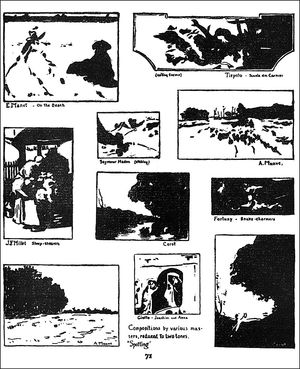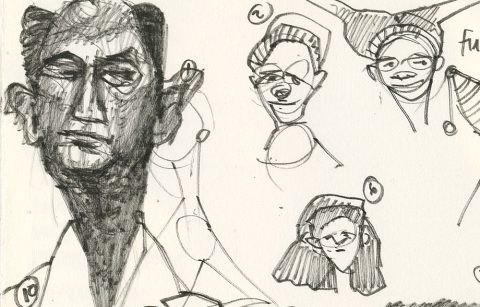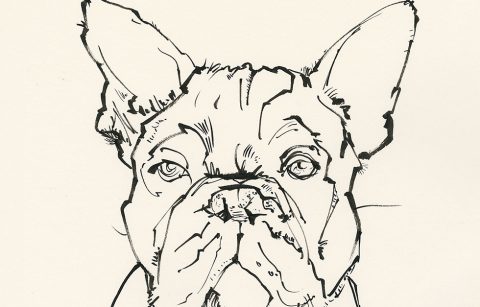Left: Spotting Notan, a diagram from Arthur Wesley Dow’s book Composition: Understanding Line, Notan and Color, ©2007 Dover Publications. Click on the image to see an enlargement.
We learn and then forget things all our lives. Sometimes we learn things and they fall from the top ten useful things we think about everyday, but somehow they still impact us. Notan is one of those things for me. I grew up in a home where a mother with an artistic bent would bring in little bits of beauty (knick knacks, paintings, ceramics) and combine them with other objects to create tableaux of beauty. Because of proximity and travel many of the items that drew my mother’s attention were Japanese. My childhood immersion has created a life-long interest in line and compositional cropping which people might dismiss as, “well that’s just Roz, she designs books after all,” (images are always being cropped for cover design effect or to make interesting chapter opening pages in textbooks). It runs deeper than that. It has to do with notan.
The term NOTAN, a Japanese word meaning “dark, light,” refers to the quantity of light reflected, or the massing of tones of different values. Notan-beauty means the harmony resulting from the combination of dark and light spaces—whether colored or not—whether in buildings, in pictures, or in nature. Careful distinction should be made between NOTAN, an element of universal beauty, and LIGHT AND SHADOW, a single fact of external nature.
This definition comes from Arthur Wesley Dow’s book (capitalization for emphasis is Dow’s), Composition: Understanding Line, Notan and Color. (Dover Publications has reprinted this book, originally printed in 1899 under the title Composition: A Series of Exercises in Art Structure for the Use of Students and Teachers.)
The black and white image at the start of this post comes from Dow’s discussion of spotting notan in the works of master painters. (The handwritten captions in the diagram are difficult to read, but include Manet, Tiepolo, Giotto, J.F. Millet, and Corot. Note: Dover actually comments about this “fault” of the book on the copyright page. They are working from an edition that wasn’t clear. Do not let this deter you: 99.9% of the reproduction is clear.)
When we look at masterworks reduced to two values we can see a powerful interaction of mass, light, and arrangement (composition, organization, design, whatever you want to call it) which gives power, grace and impact to the images. Notan is present under the line and color, always informing our mind and eye that “there is harmony here, that’s what is making this image work.”
If you are interested in making art this book is an essential read. There may be some language blocks because it was written in 1899. We use some words differently now; it is the nature of language to evolve. But if you read the book patiently, and perhaps out loud, context will help you know when a word doesn’t mean what you think it should mean, and good sense will tell you what it does mean. (I find reading aloud is the best restorer of comprehension: try it with Chaucer if you don’t believe me. I once read the first page of Pride and Prejudice to Dick and he laughed out loud; it’s impossible not to love Austen’s tone if you hear it ringing. Frankly I don’t know if you can get through Ulysses [by James Joyce] without reading aloud, just to keep your place [apologies to my college roommate], ditto Faulkner [though even if you could, why would you?]. And you become immediately aware of the new forceful voice in American fiction if you read Huckleberry Finn aloud. Let’s not get started on poetry!)
Bottom line Dow’s prose is not as lovely as Ruskin’s (another 19th century art instructor and also art critic) but Dow’s ideas are clearly laid out and there for the learning, with examples and exercises. Dow’s emphasis on the need to teach art to children and his experience doing that, informs this book and also makes it accessible.
Dow’s book will provide you with new insights into what you may intuitively find beautiful. He breaks down and explains the complicated nature of beauty in art and how one achieves it. This is useful for artists at all stages of their development, whether they are starting out or just breaking away into a new area of discovery.
Dover has done us a great service making this, and so many other wonderful, but previously out of print, art instruction books available at an affordable cost (this book is $15).
I am a firm believer that a solid foundation in practice and theory encourages creativity and spontaneity in art. You are having a dialog with past, present and future, with a vocabulary of terms and conditions all understand. There is real connection regardless of whether or not the conversation is pacific or argumentative. And perhaps even more important there is a sense of satisfaction and completeness for the artist. To practice in a random fashion may one day yield a quality result, but that result is by happenstance. How much more satisfying to achieve repeatable results and have the understanding of why the product creates that sense of beauty or successful completion (remembering of course that some beauty is after all horrible yet still beautiful: see specifically Goya).
I recommend you look at Dow’s book; and while you are at it look at other books from Dover’s list of art instruction books. The list of helpful titles grows and grows.























Hey Roz, thanks for this post!
I used a copy of the 1899 version when building my Composition class. I noticed Dover had reprinted it, in not just one version, but two. I ordered both thinking they were two different books but laughed when I got them and realized I’d ordered two versions of the same book (with small differences).
“Composition A Series of Exercises in Art Structure for the Use of Student and Teachers”
by Arthur Wesley Dow
with a new introduction by
Joseph Masheck
This title is the one with the dreary reproduction of a woodblock print by the author on the cover, and the other is…
“Composition Understanding Line, Notan and Color” by Arthur Wesley Dow
This one does not have the introduction but a much better cover featuring a Japanese woodblock, a small arts & crafts image and some photoshop lettering & illustrator art for which I’ll reserve comment. This version has the pleasant addition of color plates. I think the text is a cleaner reproduction as well.
Composition junkies may also wish to peruse “Notan The Dark Light Principle of Design” by Dorr Bothwell and Marlys Mayfield, also from Dover. Originally published in 1968 so there’s some Motherwell in there and Notan exercises in contemporary style.
Karen E
Karen, thanks for this information. I’m wondering if the version you describe with the “photoshop lettering and illustrator art” is a newer facsimile. I have that version and it was produced in 2007. The addition of the color plates do make it fun.
Thanks also for the additional title to look into!
Roz
Birgit, thanks for writing in about your search. You are looking at a different book than the one I reviewed. I think you might be looking at the first book Karen mentioned in her post above. The book you provided a link to has the same intro author and definitely has a dreary woodblock on the cover that Karen referred to. Since I purchased mine off a shelf where there were no other “similar” books I wasn’t aware of any until Karen brought it to my attention.
The book I was reviewing could actually be seen on the linked page you sent, but it was listed below in the “deal” section: buy this and this for less money. There, just below the listing for the book you found, the book I was reviewing was listed as a deal with two other books.
Use the following reference link to get to the book I reviewed, or go directly to Dover and search for it on their website. You’ll find the $14.95 book I was reviewing. (It has a yellow cover and “Composition” is in red. There is a Japanese woodblock print of a park scene with a large hill that has a cave in it. Line drawings are spread out in the background of the cover color.)
If that all fails you can call Wet Paint where I got mine. Not only is the price tag $14.95, but the price printed on the book for the U.S. is the same. The manufacturer’s Canadian price is $22.50, printed on the back of the book. (Easier still: ISBN: 0-486-46007-X)
http://www.amazon.com/Composition-Understanding-Line-Notan-Color/dp/048646007X/ref=pd_bxgy_b_img_b
Good luck!
Roz